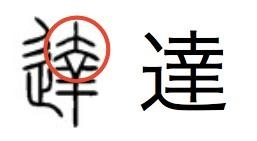 This is a guest article written by John Renfroe over at Outlier Linguistics. They’re working on a dictionary meant to teach us about functional components of Chinese characters and in this article, John describes why we should think about functional components instead of obsessing over radicals.
This is a guest article written by John Renfroe over at Outlier Linguistics. They’re working on a dictionary meant to teach us about functional components of Chinese characters and in this article, John describes why we should think about functional components instead of obsessing over radicals.
I know this advice is going to rub some people the wrong way, but hopefully by the end of the article you’ll understand why I say this: radicals are of little use for learning how characters work. Their purpose is indexing characters in a dictionary.
There’s a huge misconception about how characters work. You see this sort of advice all the time: Characters are made up of radicals, so you should learn the radicals first, or Make sure you learn the radicals, they’re the building blocks of characters
This is not true. People who say this are well-intentioned but ill-informed about the nature of the Chinese writing system. The word radical is best understood as a character component that sometimes plays the role of radical and NOT a character component that has the nature of being a radical.
For example, 大 dà “big” is a component that is on the list of radicals, but it is not the case that 大 always plays the role of radical when it appears in a character. A single character only has a single radical, no matter how many character components it has. And which of its components plays the role of radical may be different in different dictionaries.
And yes, many of the components on the list of radicals do show up a lot in Chinese characters and therefore should be learned, but they should be learned as being part of a system of functional components – components which express sound and meaning.
The concept of radical, or 部首 bùshǒu, didn’t even exist until after the publication of the Shuōwén Jiězì [說文解字], at which point the writing system had already been around for well over 1500 years, and the vast majority of characters in use today were invented before the Shuōwén. Read that again and let it sink in. If that’s the case, then there’s no way that radicals were what people had in mind when they were creating characters. There must be something else going on.
So what are radicals, really?
That’s an interesting question. The word radical is really a poor translation of 部首 bùshǒu in the first place. 部首 literally means section head. Following the model of the 說文, character dictionaries are traditionally arranged into sections containing similar graphic components.
These sections are called 部 bù in Chinese. The first character in that section is the 部首, the section head, or the first of the section. Each character in that section belongs to one 部首. Note that I didn’t say the character has one 部首. It’s an important distinction to make. The character is filed under a 部, or section. This is a choice made by the editor of a character dictionary, not an inherent part of the nature of Chinese characters.
Which section to file a character under can be a fairly arbitrary decision. Most people’s understanding is that the 部首 gives a hint about meaning and the sound component (聲符 shēngfú) gives a hint about the sound, and that the two are different entities. That’s not always the case.
Sometimes, the 部首 is the sound component. For example 刀 (刂 dāo, knife) is both the phonetic and the radical in 到, but it is not the meaning component – 至 zhì is (it means to arrive, just like 到).
Intuitively, one would think that radicals are assigned in a consistent manner, but sometimes the way they’re assigned can be very haphazard, even for characters that share the same structure:
| Character | Radical |
| 彎 wān “curve” | 弓 gōng “bow for shooting arrows” |
| 戀 liàn “love” | 心 xīn “heart” |
| 蠻 mán “barbaric” | 虫 huǐ “type of poisonous snake; early form of 虺 huǐ” |
| 變 biàn “change” | 言 yán “speech” |
For the first three characters, the radical and meaning components are same. 變 is inconsistent with the others in that it’s filed under 言 (part of luán, the sound component which the other characters all share #1).
So again, characters are filed into a given section. This is a choice made by a human being, not an inherent part of the nature of Chinese characters, and it’s a flawed but workable system.
So hopefully, you can see that radicals (remember: section headings, not necessarily meaning components!) are useful for organising and looking things up in a dictionary, but they’re not especially useful for explaining how characters work.
But there’s a better way
You should look at characters in terms of their functional components. Character components can serve a few different functions, and you need to understand those functions rather than lump them all under one category called radicals.
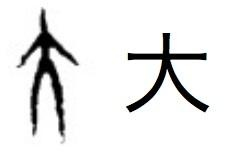 There are three attributes that all characters have (using 大 as an example):
There are three attributes that all characters have (using 大 as an example):
- Form: What is it a picture of? 大 is a picture of a person (specifically, an adult).
- Meaning: What does it mean? 大 means big, because adults are big in
comparison to children. - Sound: What is its pronunciation? (Or, if it’s a sound component, what is the range of sounds it can represent?) 大 is pronounced dà in Mandarin.
The possible functions that a component can have derive directly from these three attributes.
There are three primary functions:
- A component can express meaning by way of form. Example: 大 is a picture of a person, and that is its function in characters like 美 měi beautiful (which is not a big 大 sheep 羊, but a person wearing a headdress). This is by far the most common way of expressing meaning.

Other examples of 大 functioning in this way include: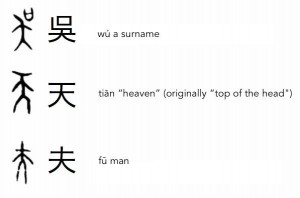
- A component can express meaning by way of meaning. Example: 大 means big, and it expresses the meaning big in characters like 尖. This is how most people explain all meaning components, but in reality this function is very uncommon!
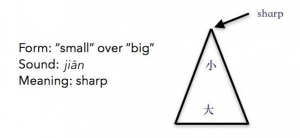
- A component can express sound. Example: 大 is pronounced dà in Mandarin, and it serves as a sound component in the simplified character 达 (#2) dá “to arrive” (traditional: 達).
Then there is a fourth function that derives from the way Chinese characters evolved in form over time. A component can also:
- Serve as a placeholder for an earlier form that has now been corrupted.
This one is difficult to ascertain without training in palaeography, but our dictionary will explain which components have been corrupted and how. Continuing with 大 as an example, there are 1) instances in which a component was originally 大 but has now changed to something else, and 2) instances in which a component started as something else but has corrupted to look like 大 today (post forthcoming on how you can t trust your eyes).
- The sound component in 達 is
 (dá). The top part today looks like 土 tǔ earth, but it was originally 大, which was then corrupted over time. An uncorrupted version of this component would look like 羍 today (#3).
(dá). The top part today looks like 土 tǔ earth, but it was originally 大, which was then corrupted over time. An uncorrupted version of this component would look like 羍 today (#3).
The form above is written in small seal script [小篆 xiǎozhuàn]. This is what 大
and 土 looked like in small seal, for comparison: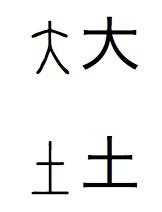
- In the character 莫 mò (do not, but originally represented the word sunset, which is now written 暮 mù), what today looks like 大 on the bottom was originally 艸 cǎo “grass” (there was 艸 on both the top and bottom, and the character depicted the sun setting behind the grass), which then corrupted over time to look like 大.
So now you’ve seen how the same component can serve completely different functions in different characters, and how components can become corrupted over time, obscuring their original purpose. Here’s the interesting thing: out of the characters I’ve just discussed, 大 is only the radical in 天 and 夫. In the others, it’s not, no matter which function it’s serving. The radical in the other characters is:
尖: 小
美: 羊
吳: 口
达/達: 辶
莫: 艹
Summary
Again, all this is not to say that you should completely throw radicals out the window. They’re good to know, but you should keep in mind what they’re used for: looking up characters in traditionally-arranged dictionaries. That’s it. They’re not the building blocks of Chinese characters (that’s functional components!). They’re an imperfect, man-made system of arranging and looking up characters in a dictionary. The concept of 部首 didn’t even exist when the vast majority of characters were being created
But sound and meaning components did exist. Sound and meaning components are the building blocks of Chinese characters. Sound and meaning components are what people were thinking of whenever they made a new Chinese character. When you’re learning a new character, thinking in terms of these functional components rather than radicals will clarify a lot of confusing things about Chinese characters. Anything that tells you otherwise is inaccurate and (unintentionally) leading you astray.
Thanks to John for sharing his insights in this article! I would like to point out that this is close to what I advocate myself, I avoid using the word radical and say character component instead. I have also written two articles about phonetic components (part 1, part 2). I like this article by John because it explains why we shouldn’t obsess about radicals. Naturally, some of the most commonly used character components will also be found in a radical list, but confusing radicals with functional components will lead to confusion.
Footnotes
1 – How can luán be the sound component for 變 biàn? This most certainly looks impossible judging from the Mandarin pronunciation, but what’s important is the phonology of the language when the characters were invented. If we look a reconstruction of Old Chinese phonology (i.e., a reconstruction of the sounds of the language that was in use when these Chinese characters were invented thousands of years ago), we can get a glimpse at what the language probably looked like.
In a future post, we’ll do an introduction to Old Chinese reconstruction and why it’s important for doing research in Chinese paleography, but for now we’ll just take a look at some reconstructions. Keep in mind, it’s not important that you understand what all of these symbols mean exactly. What is important, is noticing the similarities and differences (the symbol * just means that you are looking at a reconstruction):
䜌 *mə.rʕon (ballpark approximation “muh RON”)
變 *pron-s (ballpark approximation “prons” or “prawns”)
蠻 *mʕron (ballpark approximation “mron” or “mrawn”)
戀 *ron-s (ballpark approximation “rons” or “Ron’s”)
The main thing to take away here, is that each of these words share the root *ron. Three of these words have prefixes: *məә, *p-, *m- and two have suffixes *-s. It is similar to how root words work in English. Take the root “get”: get, forget, beget, got, gotten. Imagine that Chinese characters had been used in Old English and the same sound component was used for each of these words.Even though the sounds aren’t exactly the same, they do share a root and the reader would have been able to figure out which was meant by context and by the addition of a meaning component.
Keep in mind, I’m merely trying to make an analogy between two languages with very different histories, so be kind. The reconstructions above are from Baxter-Sagart OC v1. Check out their new book here.
2 – 达 is not a recent invention. It’s a variant of 達 attested as early as the oracle bone script [甲骨文jiǎgǔwén].
3 – ![]() is also a meaning component. 达 is a picture of a guy walking across the road. The original meaning was “arrive at point b from point a”. 達 is the same thing, but has a guy leading a sheep from point a to b.
is also a meaning component. 达 is a picture of a guy walking across the road. The original meaning was “arrive at point b from point a”. 達 is the same thing, but has a guy leading a sheep from point a to b.

Tips and tricks for how to learn Chinese directly in your inbox
I've been learning and teaching Chinese for more than a decade. My goal is to help you find a way of learning that works for you. Sign up to my newsletter for a 7-day crash course in how to learn, as well as weekly ideas for how to improve your learning!

7 comments
This should be extremely simplified for beginners like me, but I think that I get the idea behind it. Thanks. Now when I see a radical, I will remember that it can have different functions (meaning function by visual clues most of the time, or meaning clues + sound function).
Hello Olle,
getting inspiration from your pages once again.
Just wanted to let you know the link for Shuōwén Jiězì [說文解字] does not lead to the intended page anymore. If it can be changed, please do so.
All the best
MH
You told that Chinese components express both meaning and pronunciation.
My doubt is how to find which part of the character gives the meaning and pronunciation.
Please reply
Usually, the sound-bearing component is on the right, but not always. The Outlier dictionary shows this, but there’s also basic information about this in dictionaries like Zdic.net.